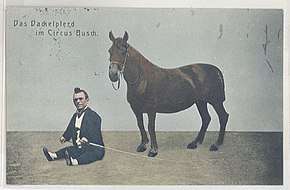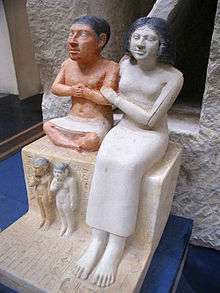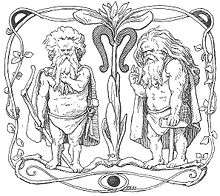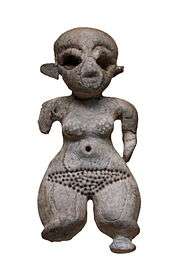Dwarfism
Dwarfism, also known as short stature, occurs when an organism is extremely small.[1] In humans, it is sometimes defined as an adult height of less than 147 centimetres (4 ft 10 in), regardless of sex, although some individuals with dwarfism are slightly taller.[2][3] Disproportionate dwarfism is characterized by either short limbs or a short torso. In cases of proportionate dwarfism, both the limbs and torso are unusually small. Intelligence is usually normal, and most have a nearly normal life expectancy.[4][5]
| Dwarfism | |
|---|---|
 | |
| A man in Columbus, Indiana, USA with dwarfism caused by achondroplasia | |
| Pronunciation |
|
| Specialty | Endocrinology, medical genetics |
| Causes | Hyposecretion of growth hormone from pituitary gland (growth hormone deficiency), genetic disorders |
The most common and recognisable form of dwarfism in humans is the genetic disorder achondroplasia, comprising 70% of cases.[6] Growth hormone deficiency is responsible for most other cases.[7] Treatment depends on the underlying cause. Those with genetic disorders can sometimes be treated with surgery or physical therapy. Hormone disorders can also be treated with growth hormone therapy before the child's growth plates fuse. Individual accommodations, such as specialized furniture, are often used by people with dwarfism.[8] Many support groups provide services to aid individuals and the discrimination they may face.[9]
In addition to the medical aspect of the condition, there are also social aspects. For a person with dwarfism, height discrimination can lead to ridicule in childhood and discrimination in adulthood.[10][11] In the United Kingdom, United States, Canada, Australia and other English-speaking countries, some people with dwarfism prefer to be called dwarfs, little people or persons of short stature.[12][13] Historically, the term "midget" was used to describe proportionate dwarfs; however, this term is now regarded as offensive by some.[14]
Signs and symptoms

A defining characteristic of dwarfism is an adult height less than the 2.3rd percentile of the CDC standard growth charts. There is a wide range of physical characteristics. Variations in individuals are identified by diagnosing and monitoring the underlying disorders. There may not be any complications outside adapting to their size.
Short stature is a common replacement of the term 'dwarfism', especially in a medical context. Short stature is clinically defined as a height within the lowest 2.3% of those in the general population. However, those with mild skeletal dysplasias may not be affected by dwarfism. In some cases of untreated hypochondroplasia, males grow up to 5 feet 5 inches. Though that is short in a relative context, it does not fall into the extreme ranges of the growth charts.
Disproportionate dwarfism is characterized by shortened limbs or a shortened torso. In achondroplasia one has an average-sized trunk with short limbs and a larger forehead.[15] Facial features are often affected and individual body parts may have problems associated with them. Spinal stenosis, ear infection, and hydrocephalus are common. In case of spinal dysostosis, one has a small trunk, with average-sized limbs.
Proportionate dwarfism is marked by a short torso with short limbs,[16] thus leading to a height that is significantly below average. There may be long periods without any significant growth. Sexual development is often delayed or impaired into adulthood. This dwarfism type is caused by an endocrine disorder and not a skeletal dysplasia.
Physical effects of malformed bones vary according to the specific disease. Many involve joint pain caused by abnormal bone alignment, or from nerve compression.[12] Early degenerative joint disease, exaggerated lordosis or scoliosis, and constriction of spinal cord or nerve roots can cause pain and disability.[17] Reduced thoracic size can restrict lung growth and reduce pulmonary function. Some forms of dwarfism are associated with disordered function of other organs, such as the brain or liver, sometimes severely enough to be more of an impairment than the unusual bone growth.[18][19]
Mental effects also vary according to the specific underlying syndrome. In most cases of skeletal dysplasia, such as achondroplasia, mental function is not impaired.[16] However, there are syndromes which can affect the cranial structure and growth of the brain, severely impairing mental capacity. Unless the brain is directly affected by the underlying disorder, there is little to no chance of mental impairment that can be attributed to dwarfism.[20]
The psycho-social limitations of society may be more disabling than the physical symptoms, especially in childhood and adolescence, but people with dwarfism vary greatly in the degree to which social participation and emotional health are affected.
- Social prejudice against extreme shortness may reduce social and marital opportunities.[21][22]
- Numerous studies have demonstrated reduced employment opportunities. Severe shortness is associated with lower income.[22]
- Self-esteem may suffer and family relationships may be affected.
- Extreme shortness (in the low 2–3-foot [60–90 cm] range) can, if not accommodated for, interfere with activities of daily living, like driving or using countertops built for taller people. Other common attributes of dwarfism such as bowed knees and unusually short fingers can lead to back problems and difficulty in walking and handling objects.
- Children with dwarfism are particularly vulnerable to teasing and ridicule from classmates. Because dwarfism is relatively uncommon, children may feel isolated from their peers.[18]
Causes

Dwarfism can result from many medical conditions, each with its own separate symptoms and causes. Extreme shortness in humans with proportional body parts usually has a hormonal cause, such as growth-hormone deficiency, once called pituitary dwarfism.[12][15] Two disorders, achondroplasia and growth hormone deficiency, are responsible for the majority of human dwarfism cases.[7]
Achondroplasia
The most recognizable and most common form of dwarfism in humans is achondroplasia, which accounts for 70% of dwarfism cases, and occurs in 4 to 15 out of 100,000 live births.[6]
It produces rhizomelic short limbs, increased spinal curvature, and distortion of skull growth. In achondroplasia the body's limbs are proportionately shorter than the trunk (abdominal area), with a larger head than average and characteristic facial features. Achondroplasia is an autosomal dominant disorder caused by the presence of a faulty allele in the genome. If a pair of achondroplasia alleles are present, the result is fatal. Achondroplasia is a mutation in the fibroblast growth factor receptor 3.[24] In the context of achondroplasia, this mutation causes FGFR3 to become constitutively active, inhibiting bone growth.[25]
Research by urologist Harry Fisch of the Male Reproductive Center at Columbia Presbyterian Hospital indicates that in humans this defect may be exclusively inherited from the father and becomes increasingly probable with paternal age: specifically males reproducing after 35.[26]
Growth hormone deficiency
Growth hormone deficiency (GHD) is a medical condition in which the body produces insufficient growth hormone. Growth hormone, also called somatotropin, is a polypeptide hormone which stimulates growth and cell reproduction. If this hormone is lacking, stunted or even halted growth may become apparent. Children with this disorder may grow slowly and puberty may be delayed by several years or indefinitely. Growth hormone deficiency has no single definite cause. It can be caused by mutations of specific genes, damage to the pituitary gland, Turner's syndrome, poor nutrition,[27] or even stress (leading to psychogenic dwarfism). Laron syndrome (growth hormone insensitivity) is another cause. Those with growth hormone issues tend to be proportionate.
Other
Other causes of dwarfism are spondyloepiphyseal dysplasia congenita, diastrophic dysplasia, pseudoachondroplasia, hypochondroplasia, Noonan syndrome, primordial dwarfism, Turner syndrome, osteogenesis imperfecta (OI), and hypothyroidism. Severe shortness with skeletal distortion also occurs in several of the Mucopolysaccharidoses and other storage disorders.[28] Hypogonadotropic hypogonadism may cause proportionate, yet temporary, dwarfism.
Serious chronic illnesses may produce dwarfism as a side effect. Harsh environmental conditions, such as malnutrition, may also produce dwarfism. These types of dwarfism are indirect consequences of the generally unhealthy or malnourished condition of the individual, and not of any specific disease. The dwarfism often takes the form of simple short stature, without any deformities, thus leading to proportionate dwarfism. In societies where poor nutrition is widespread, the average height of the population may be reduced below its genetic potential by the lack of proper nutrition. Sometimes there is no definitive cause of short stature.
Diagnosis
Dwarfism is often diagnosed in childhood on the basis of visible symptoms. A physical examination can usually suffice to diagnose certain types of dwarfism, but genetic testing and diagnostic imaging may be used to determine the exact condition.[29] In a person's youth, growth charts that track height can be used to diagnose subtle forms of dwarfism that have no other striking physical characteristics.[7]
Short stature or stunted growth during youth is usually what brings the condition to medical attention. Skeletal dysplasia is usually suspected because of obvious physical features (e.g., unusual configuration of face or shape of skull), because of an obviously affected parent, or because body measurements (arm span, upper to lower segment ratio) indicate disproportion.[29] Bone X-rays are often key to diagnosing a specific skeletal dysplasia, but are not the sole diagnostic tool. Most children with suspected skeletal dysplasias are referred to a genetics clinic for diagnostic confirmation and genetic counseling. Since about the year 2000, genetic tests for some of the specific disorders have become available.[30]
During an initial medical evaluation of shortness, the absence of disproportion and other clues listed above usually indicates causes other than bone dysplasias.
Classification

In men and women, the sole requirement for being considered a dwarf is having an adult height under 147 cm (4 ft 10 in) and it is almost always classified with respect to the underlying condition that is the cause of the short stature. Dwarfism is usually caused by a genetic variant; achondroplasia is caused by a mutation on chromosome 4. If dwarfism is caused by a medical disorder, the person is referred to by the underlying diagnosed disorder. Disorders causing dwarfism are often classified by proportionality. Disproportionate dwarfism describes disorders that cause unusual proportions of the body parts, while proportionate dwarfism results in a generally uniform stunting of the body.
Disorders that cause dwarfism may be classified according to one of hundreds of names, which are usually permutations of the following roots:
- location
- rhizomelic = root, i.e., bones of the upper arm or thigh
- mesomelic = middle, i.e., bones of the forearm or lower leg
- acromelic = end, i.e., bones of hands and feet.
- micromelic = entire limbs are shortened
- source
- chondro = of cartilage
- osteo = of bone
- spondylo = of the vertebrae
- plasia = form
- trophy = growth
Examples include achondroplasia and chondrodystrophy.
Prevention
Many types of dwarfism are currently impossible to prevent because they are genetically caused. Genetic conditions that cause dwarfism may be identified with genetic testing, by screening for the specific variations that result in the condition. However, due to the number of causes of dwarfism, it may be impossible to determine definitively if a child will be born with dwarfism.
Dwarfism resulting from malnutrition or a hormonal abnormality may be treated with an appropriate diet or hormonal therapy. Growth hormone deficiency may be remedied via injections of human growth hormone (HGH) during early life.[31]
Management
Genetic mutations of most forms of dwarfism caused by bone dysplasia cannot be altered yet, so therapeutic interventions are typically aimed at preventing or reducing pain or physical disability, increasing adult height, or mitigating psychosocial stresses and enhancing social adaptation.[9]
Forms of dwarfism associated with the endocrine system may be treated using hormonal therapy. If the cause is prepubescent hyposecretion of growth hormone, supplemental growth hormone may correct the abnormality. If the receptor for growth hormone is itself affected, the condition may prove harder to treat. Hypothyroidism is another possible cause of dwarfism that can be treated through hormonal therapy. Injections of thyroid hormone can mitigate the effects of the condition, but lack of proportion may be permanent.
Pain and disability may be ameliorated by physical therapy, braces or other orthotic devices, or by surgical procedures.[9] The only simple interventions that increase perceived adult height are dress enhancements, such as shoe lifts or hairstyle. Growth hormone is rarely used for shortness caused by bone dysplasias, since the height benefit is typically small (less than 5 cm [2 in]) and the cost high.[8] The most effective means of increasing adult height by several inches is distraction osteogenesis, though availability is limited and the cost is high in terms of money, discomfort, and disruption of life. Most people with dwarfism do not choose this option, and it remains controversial.[12] For other types of dwarfism, surgical treatment is not possible.
Society and culture
Terminology

The appropriate term for describing a person of particularly short stature (or with the genetic condition achondroplasia) has historically been ambiguous, and has developed euphemistically over the past few centuries.
The noun dwarf stems from Old English dweorg, originally referring to a being from Germanic mythology—a dwarf—that dwells in mountains and in the earth, and is associated with wisdom, smithing, mining, and crafting. The etymology of the word dwarf is contested, and scholars have proposed varying theories about the origins of the being, including that dwarfs may have originated as nature spirits or as beings associated with death, or as a mixture of concepts. Competing etymologies include a basis in the Indo-European root *dheur- (meaning 'damage'), the Indo-European root *dhreugh (whence modern German Traum 'dream' and Trug 'deception'), and comparisons have been made with the Old Indian dhvaras (a type of demonic being). The being may not have gained associations with small stature until a later period.[32]
The terms "dwarf", "little person", "LP", and "person of short stature" are now generally considered acceptable by most people affected by these disorders.[15] However, the plural "dwarfs" as opposed to "dwarves" is generally preferred in the medical context, possibly because the plural "dwarves" was popularized by author J.R.R. Tolkien, describing a race of characters in his The Lord of the Rings books resembling Norse dwarfs.[33]
"Midget", whose etymology indicates a "tiny biting insect",[34] came into prominence in the mid-19th century after Harriet Beecher Stowe used it in her novels Sunny Memories of Foreign Lands and Old Town Folks where she described children and an extremely short man, respectively.[15] Later some people of short stature considered the word to be offensive because it was the descriptive term applied to P. T. Barnum's dwarfs used for public amusement during the freak show era.[12][35] It is also not considered accurate as it is not a medical term or diagnosis, though it is sometimes used as a slang term to describe those who are particularly short, whether or not they have dwarfism.[36]
Dwarf sports
Dwarfs are supported to compete in sport by a number of organisations nationally and internationally.
The Dwarf Athletic Association of America and the Dwarf Sports Association UK provide opportunities for dwarfs to compete nationally and internationally in the Americas and Europe respectively.
The Dwarf Sports Association UK organises between 5 and 20 events per month for athletes with restricted growth conditions in the UK.[37]
For instance, swimming and bicycling are often recommended for people with skeletal dysplasias, since those activities put minimal pressure on the spine.[38]
Since its early days, professional wrestling has had the involvement of dwarf athletes. "Midget wrestling" had its heyday in the 1950s–70s, when wrestlers such as Little Beaver, Lord Littlebrook, and Fuzzy Cupid toured North America, and Sky Low Low was the first holder of the National Wrestling Alliance's World Midget Championship. In the following couple of decades, more wrestlers became prominent in North America, including foreign wrestlers like Japan's Little Tokyo. Although the term is seen by some as pejorative, many past and current midget wrestlers, including Hornswoggle, have said they take pride in the term due to its history in the industry and its marketability.
Art and media depictions

In art, literature, and movies, dwarfs are rarely depicted as ordinary people who are very short but rather as a species apart. Novelists, artists, and moviemakers may attach special moral or aesthetic significance to their "apartness" or misshapenness.
Artistic representations of dwarfism can be found on Greek vases and other ancient artifacts, including ancient Egyptian art in which dwarfs are likely to have been seen as a divine manifestation, with records indicating they could reach high positions in society.[39][40]
The Bhagavat Purana Hindu text devotes nine chapters to the adventures of Vamana, a dwarf avatar of Lord Vishnu.
Depictions of dwarfism are also found in European paintings and many illustrations. Many European paintings (especially Spanish) of the 16th–19th centuries depict dwarfs by themselves or with others. In the Talmud, it is said that the second born son of the Egyptian Pharaoh of the Bible was a dwarf.[41] Recent scholarship has suggested that ancient Egyptians held dwarfs in high esteem.[42] Several important mythological figures of the North American Wyandot nation are portrayed as dwarfs.[43]
As popular media have become more widespread, the number of works depicting dwarfs have increased dramatically. Dwarfism is depicted in many books, films, and TV series such as Willow, The Wild Wild West, The Man with the Golden Gun (and later parodied in Austin Powers), Gulliver's Travels by Jonathan Swift,[44] The Wizard of Oz, Willy Wonka & the Chocolate Factory, Bad Santa, A Son of the Circus, Little People Big World, The Little Couple, A Song of Ice and Fire (and its TV adaptation Game of Thrones), Seinfeld, The Orator, In Bruges, The Tin Drum by Günter Grass, the short-lived reality show The Littlest Groom, and the films The Station Agent and Zero.
The Animal Planet TV series Pit Boss features dwarf actor Shorty Rossi and his talent agency, "Shortywood Productions", which Rossi uses to provide funding for his pit bull rescue operation, "Shorty's Rescue". Rossi's three full-time employees, featured in the series, are all little people and aspiring actors.
In September 2014, Creative Business House, along with Donnons Leur Une Chance, created the International Dwarf Fashion Show to raise awareness and boost self-confidence of people living with dwarfism.[45]
See also
- Dwarfs and pygmies in Ancient Egypt
- Dwarf-tossing
- Ellis–van Creveld syndrome
- Gigantism
- Human height
- Kingdom of the Little People
- Laron syndrome
- List of people with dwarfism
- List of restricted growth organisations around the world
- List of shortest people
- Mulibrey nanism
- Our Little Life (reality television show)
- Phyletic dwarfism
References
- "Definition of DWARFISM". Merriam-webster.com. Retrieved 2017-05-04.
- "MedlinePlus: Dwarfism". MedlinePlus. National Institute of Health. 2008-08-04. Retrieved 2008-10-03.
- "FAQ". Lpaonline.org. Retrieved 2017-05-04.
- "Restricted growth (dwarfism) - NHS Choices". Nhs.uk. Retrieved 2017-05-04.
- Pauli, RM; Adam, MP; Ardinger, HH; Pagon, RA; Wallace, SE; Bean, LJH; Mefford, HC; Stephens, K; Amemiya, A; Ledbetter, N (2012). "Achondroplasia". GeneReviews. PMID 20301331.
- "Wayback Machine" (PDF). July 13, 2018. Archived from the original (PDF) on July 13, 2018.
- "Dwarfism". KidsHealth. Retrieved 2015-06-30.
- Hagenäs L, Hertel T (2003). "Skeletal dysplasia, growth hormone treatment and body proportion: comparison with other syndromic and non-syndromic short children". Horm. Res. 60 Suppl 3: 65–70. doi:10.1159/000074504. PMID 14671400. Retrieved 2008-11-17.
- "Dwarfism: Treatment and drugs". MayoClinic.com. Mayo Foundation for Medical Education and Research. 2007-09-27. Retrieved 2008-11-18.
- University of Pennsylvania, Arts and Sciences: "The Effect of Adolescent Experience on Labor Market Outcomes: The Case of Height" Archived 2007-07-10 at the Wayback Machine.
- "Science Blog -- Short children more likely to be bullied at school". 3.scienceblog.com.
- "Dwarfism Resources: Frequently Asked Questions". Little People of America. 2006-07-09. Archived from the original on 2006-05-16. Retrieved 2006-11-14.
- "LittlePeople UK". Retrieved 3 October 2013.
- "Definition of MIDGET". Merriam-webster.com.
- Kennedy, Dan. "P.O.V. – Big Enough. What is Dwarfism?". Public Broadcasting Service. Retrieved 2008-11-18.
- "Dwarfism: Symptoms". MayoClinic.com. Mayo Foundation for Medical Education and Research. Retrieved 2009-01-29.
- "Dwarfism and Bone Dysplasias". Seattle Children's Hospital, Research & Foundation. Archived from the original on 2007-05-04. Retrieved 2008-11-18.
- "Dwarfism: Complications". MayoClinic.com. Mayo Foundation for Medical Education and Research. Retrieved 2008-11-18.
- Escamilla RF, Hutchings JJ, Li CH, Forsham P (August 1966). "Achondroplastic dwarfism. Effects of treatment with human growth hormone". Calif Med. 105 (2): 104–10. PMC 1516352. PMID 5946547.
- "The Pituitary Gland & Growth Disorders: An Overview". Archived from the original on 2013-02-10. Retrieved 2009-02-22.
- Hall, Judith A.; Adelson, Betty M. (2005). Dwarfism: medical and psychosocial aspects of profound short stature. Baltimore: Johns Hopkins University Press. ISBN 0-8018-8121-8.
- Gollust SE, Thompson RE, Gooding HC, Biesecker BB (August 2003). "Living with achondroplasia in an average-sized world: an assessment of quality of life". American Journal of Medical Genetics Part A. 120A (4): 447–58. doi:10.1002/ajmg.a.20127. PMID 12884421.
- Ancient Egypt: Kingdom of the Pharaohs, R. Hamilton, p. 47, Paragon, 2006, ISBN 1-4054-8288-5
- FGFR3
- "Achondroplasia – Genetics Home Reference". Genetics Home Reference. National Institute of Health. 2008-09-26. Retrieved 2008-10-01.
- Harry Fisch (24 September 2013). The Male Biological Clock: The Startling News About Aging, Sexuality, and Fertility in Men. Simon and Schuster. pp. 11–. ISBN 978-1-4767-4082-9.
- "Growth Hormone Deficiency". UK Child Growth Foundation. Archived from the original on 2009-01-16. Retrieved 2009-01-16.
- "Causes of Dwarfism". WrongDiagnosis.com. Retrieved 2009-03-23.
- "DWARFISM (Algorithmic Diagnosis of Symptoms and Signs) - WrongDiagnosis.com". Retrieved 2009-02-22.
- "Dwarfism: Tests and diagnosis". Mayo Clinic. Mayo Foundation for Medical Education and Research. 2007-08-27. Retrieved 2008-11-18.
- Jørgensen, Jens O.L.; Christiansen, Jens S. (2005), "Clinical Aspects of Growth Hormone Deficiency in Adults", Growth Hormone Deficiency in Adults, KARGER, pp. 1–20, ISBN 3-8055-7992-6, retrieved 2020-05-28
- Simek, Rudolf (2007) translated by Angela Hall. Dictionary of Northern Mythology, pp. 67–68. D.S. Brewer ISBN 0-85991-513-1
- Tolkien, John Ronald Reuel (1955). The Return of the King. George Allen & Unwin. pp. Appendix F.
- "midget". Online Etymology Dictionary. Dictionary.com. Retrieved 2008-11-18.
- Adelson, Betty M. (2005). The Lives Of Dwarfs: Their Journey From Public Curiosity Toward Social Liberation. Rutgers University Press. p. 295. ISBN 9780813535487. Retrieved 8 December 2012.
- "Midget definition". MedicineNet. MedicineNet, Inc. 9 March 2003. Retrieved 2008-11-18.
- "DSAuk Events". Dsauk.org. Retrieved 2016-02-27.
- Philadelphia, The Children's Hospital of (25 March 2014). "Skeletal Dysplasias". Chop.edu.
- Ancient Egyptian Medicine, John F. Nunn, University of Oklahoma Press, 2002, pp. 78–79, ISBN 0-8061-3504-2
- "Dwarfs Commanded Respect In Ancient Egypt". Sciencedaily.com.
- The Talmud – Chapter VI. Death Of Jacob And His Sons – Moses – The Deliverance From Egypt. URL accessed April 23, 2007.
- Kozma, Chahira (2005-12-27). "Dwarfs in ancient Egypt". American Journal of Medical Genetics. 140A (4): 303–11. doi:10.1002/ajmg.a.31068. PMID 16380966. Archived from the original on 2013-01-05. Retrieved 2008-11-12.
- Trigger, Bruce G., The Children of Aataentsic: A History of the Huron People to 1660 McGill-Queen's University Press, 1987 ISBN 0-7735-0627-6, p. 529.
- Gulliver's Travels: Complete, Authoritative Text with Biographical and Historical Contexts, Palgrave Macmillan 1995 (p. 21). The quote has been misattributed to Alexander Pope, who wrote to Swift in praise of the book just a day earlier.
- Stark, Stephanie. "The Dwarf Fashion Show Debuts in New York City". Glammonitor. Retrieved 22 July 2015.
External links
| Classification | |
|---|---|
| External resources |
| Wikimedia Commons has media related to Dwarfism. |
| Look up dwarf in Wiktionary, the free dictionary. |
- Little People of the World Organization
- Little People of America (Includes a list of International support groups)
- Little People of Canada (Includes a list of Canadian Provincial support groups)
- Little People UK
- Dwarf Sports Association UK
- Restricted Growth Association UK
.jpg)